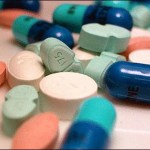The word drug comes from Drogue meaning ‘a dry herb’. A drug can be defined as:
“A substance, material or product used for the purpose of diagnosis, prevention and relief of symptoms or cure of disease.”
WHO defines drug as:
“A substance, material or product used or intended to be used to modify or explore the physiological processes or pathological states for the benefit of the recipient.”
 Photo by publik15
Photo by publik15
General Features of a Drug:
1. Variability in molecular size
2. Variability in shape
3. Variability in chemical nature
4. Variability in lipid/water partition coefficient
5. Variability in degree of ionization
6. Physical Properties
1. Variability in molecular size
Smaller sized molecules are easily absorbed than larger molecules. Normally the molecular weight is between 100-1000 but may be higher or lower. Streptokinase is an example of large molecular weight drug while lithium or nitric oxides are of small molecular weight.
2. Variability in shape
Drugs may be globular or linear in structure. Their shape is modified according to the receptor on which they act.
3. Variability in chemical nature
Tertiary compounds are lipid soluble while the quaternary compounds are water soluble. Tertiary compounds can cross the membranes easily as compared to the quaternary compounds. This is because of the fact that the quaternary compounds are ionized.
4. Variability in lipid/water partition coefficient
Lipid soluble drugs (having higher lipid water partition coefficient) are more retained in the body while water soluble drugs are easily excreted out.
5. Variability in degree of ionization
Polar or ionized forms of drugs are lipid insoluble. Non polar drugs are water insoluble or lipid soluble. Ionized forms of drugs can pass through the specific places i.e. through channels like Na+ and K+ channels.
6. Physical Properties
Drugs may be solids, liquids or gases. Examples include halothane and nitrous oxide, both of which are gases.
Solubility of gases is greater than that of liquids, while solubility of liquids is greater than that of solids.
Rational Drug Therapy
Administration of the right drug indicated for the disease in right dose through an appropriate route for the right duration.
Rational drug therapy applies to the doctor.
Drug Abuse
Drug when used for non medical purposes is known as drug abuse. It is the wrong use of a drug other than for the disease e.g. addiction of certain drugs, like morphine, nicotine.
Misuse of Drug
Drug that is not required by the patient i.e. drug therapy that is not justified. If violate the quantity or duration of the required drug, it is known as misuse.
History of Drug Development
Drug Development in Ancient Civilizations:
Egyptian– Medical Papyrus 1600 B.C
Ebers Papyrus 1550 B.C
China– Shen Nung
India- Ayurvedic medicine
Ancient Greek Culture– Hippocrates 460-377 B.C
Galen 130-201 A.D
Roman– Theophrastus 372-287 B.C
Dioscorides 57 A.D
Persians
Drug Development during the Middle Ages
Paracelsus (1493) is known as grandfather of science of pharmacology. According to him:
a. Most body reactions are chemical in nature
b. One must never use a combination of drugs.
c. Every drug is a poison; it is the dose that matters.
- Development in chemistry
-
Development in botany
a. Opium poppy
b. Cinchona bark- for malaria
c. Digitoxin from Digitalis purpura- for edema due to cardiac failure
d. Castor oil- for constipation
e. Atropa belladonna- source of atropine and thiosine
f. Hyoscyamus Niger- source of thiosine
Morphine was isolated as a pure compound in 1805.
Claude Bernard in 1856 found Curare
Fleming in 1928 found Benzyl penicillin which became the first antibiotic.
Modern Drug Development
a. Salicylic acid- anti-inflammatory, synthesized from phenol in 1800 by Kolbe and Lautemann.
b. Acetyl salicylic acid (aspirin) was synthesized from salicylic acid in 1899 by Dreser.
c. Prontosil, therapeutically inactive dye is transformed in the body to an antibacterial sulfonamide, was developed by Domagk in 1935.
d. Acetazolamide and thiazide are diuretics
e. Sulfonyl ureas are anti diabetic.
f. H1 antihistamines were developed by Bovet in 1944
g. Beta adrenoreceptors were discovered by James Black in 1960
h. H2 antagonists (Cimetidine for peptic ulcer) were developed in 1970,
i. Immunoglobulins and gene therapy
Want a clearer concept, also see
 howMed Know Yourself
howMed Know Yourself





Gr8ful man, my problem as been solve with these: refrence